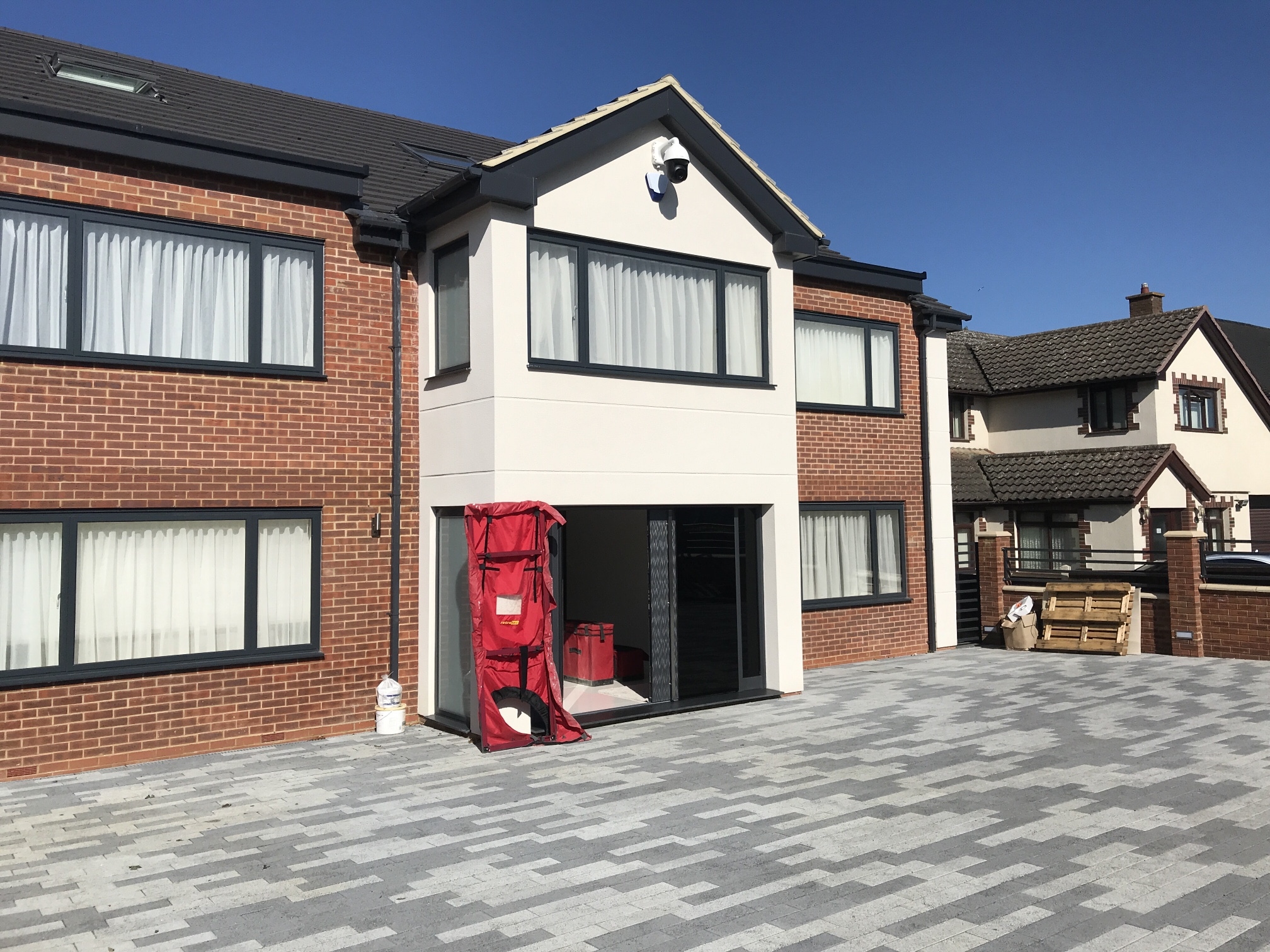[vc_row uxb_theme_class=””][vc_column uxb_theme_class=””][vc_column_text]Passivhaus is a low-energy performance standard that can be applied to many types of buildings, from homes, care homes, schools, hotels, and supermarkets. This aims to reduce room heating and cooling energy demand while providing excellent indoor comfort levels. This is accomplished mainly by following a “fabric first” approach to construction, with very high airtightness, improved insulation rates and decreased thermal bridging, and the use of mechanical ventilation with heat recovery.
Airtightness is an integral part of building energy-efficient and a Building Regulations necessity. According to NHBC, home energy usage accounts for nearly 27% of UK carbon dioxide emissions. A 2002 BRE report found that air leakage can account for up to 40% of building heat loss. Buildings designed to meet the Passivhaus specification achieve a 75% reduction in space heating requirements compared to standard practise for new buildings in the UK. Therefore, the Passivhaus model provides a reliable approach to help the construction industry achieve the government’s goal of reducing carbon emissions by 80% by 2050.
Airtightness with Passivhaus
The key principle for achieving airtightness is to create a single, continuous, durable airtight layer covering the building’s heated area. It is typically located on the insulation’s warm side, thus also fulfilling the vapour control layer requirements.
To obtain Passivhaus certification, under test conditions, a building must achieve airtightness of less or equal to 0.6 air changes per hour. This is expressed as n50≤0.6h-1 @50 Pa, where n50 is defined as the number of air changes per hour at a 50 Pa reference pressure difference. The result is measured using the building’s internal air volume (m3) instead of its surface area (m2), thus the units are expressed as m3/m3.h, simplified to h-1. This must be the average pressure and depressurization conducted using a blower door sample. Meeting this level of airtightness is difficult but achievable with a clear design plan, with the final result being sensitive to on-site workmanship quality
Current Building Regulations require air permeability at 50Pa to be 7-10m3/h/m2, depending on whether a project is in England, Wales, Scotland or Northern Ireland, so the Passivhaus limit is about five times lower than the maximum allowed. A uniform comparison between air-permeability values and n50 air-change rate values is not feasible because there is no direct relationship and each uses different test and measurement protocols. But to put this in context, the airtightness rate of n50 ≤0.6 h-1 @ 50 Pa is roughly equivalent to a crack in the building’s envelope that is less than a 5p piece per 5m2. For contrast, a building that meets the restricting airtightness requirement for Part L (2013) of the Building Regulations (Section 6 of Building Standards, Scotland and Building Regulations Part F, Northern Ireland) would have a 20p piece gap per 1m2 of envelope.[/vc_column_text][vc_single_image image=”1927″ img_size=”medium_large” image_position=”normal-align-center”][vc_column_text]
AIRTIGHT PRODUCTS
Traditionally, air and vapour control layer (AVCL) membranes have been used to achieve airtightness, although there is surprisingly no industry standard or test process. The degree of vapour diffusion depends on the composition of the material and the quality of such systems depends on site design, installation and workmanship.
An alternative is to use certified air and vapour-tight oriented strandboard (OSB). Standard OSB (and other wood panel types such as plywood, particleboard and MDF) are not ideal as an air and vapour tight layer as their air and vapour permeability is variable and can vary greatly between production cycles and production sites. Air and vapour-tight OSB is a new technology: a structural OSB panel that has built-in vapour control and air-barrier properties for the timber frame industry.
The main British and European specifications regulating specification and use of OSB panels are BS EN 300 and BS EN 13986.
BS EN 300 provides a classification system specifying four OSB levels in terms of mechanical quality and relative moisture resistance.
These are:
• OSB1: general purpose boards and boards for interior fittings (including furniture) for use in dry conditions
• OSB2: Load-bearing boards for use in dry conditions
• OSB3: Load-bearing boards for use in humid conditions
• OSB4: heavy-duty load-bearing boards for use in humid conditions.
OSB3 is suitable for a variety of internal and protected external uses including roofing, sarking, flooring, site hoarding and sheathing for external walls, partition walls, internal walls and partitions, spandrel (gable) panels, warm walls, reverse walls and insulated structural panels.
Air and vapour tight OSB panels (classified as OSB3) offer an alternative to air and vapour control layer membranes. The panels are air-and vapour-tight, ensuring airtightness and preventing interstitial condensation within the timber frame structure without a separate membrane.
OSB is made of softwood wood strands such as spruce and pine, wrapped in three layers with a moisture-resistant, formaldehyde-free synthetic resin (bottom, core and top surface) and pressed under high temperature and pressure to form a rigid and dimensional stable wood board. The wood strands are alternately bent by 90 ° to the right angles to the outer layers. This distributes the strength, stiffness and spanning capacity of the finished OSB panels, which are approximately twice as strong in length (major axis) as in width (minor axis).
To address the unpredictable air permeability in conventional OSB, care is taken during production to minimise differences in density and air gaps. Most air and vapour tight OSB panels are accredited by the Passive House Institute (PHI) to achieve maximum air permeability of 0.01m3/(m2h) (PHI Class A).
To overcome inconsistent vapour permeability in OSB, a water vapour-resistant polymer coating coats the inside of the panels. It provides consistently high-water vapour resistance across the panel layer, and its smoothness also guarantees good airtight tape adhesion at panel joints.
TIMBER-FRAME BUILDINGS VAPOUR CONTROL
In timber-frame buildings in cool temperate climates, the hot side (inside) of thermal insulation requires a vapour control layer to prevent excess water vapour from spreading into the building fabric. Warm air contains more water vapour than cold air and has higher vapour pressure. Vapor diffusion transfer occurs when the hot, humid air inside a building migrates (diffuses) through the building fabric to the low vapour pressure cold air (outside). If this vapour transfer is uncontrolled, condensation within the building fabric (interstitial condensation) can occur as moist air cools and vapour condenses on the assembly’s cold side. Therefore, the vapour control layer’s function is to limit the amount of water vapour entering the building fabric.
Air and vapour-tight OSB panels can also help prevent summer condensation by serving as a buffer. Materials made from cellulose fibres are hygroscopic and therefore can absorb and release small amounts of water vapour from the surrounding environment. In the limited number of cases of reverse vapour diffusion, OSB panels can help to prevent condensation within a structure. This is where moisture from a building envelope’s outer leaf is warmed by summer sun and permeates to the cooler inner layers, creating a possible condensation hazard unless managed or planned.
Research into the suitability of OSB panels as the air and vapour barrier in timber-frame structures found that installation reliability was as important as the panels ‘ intrinsic vapour resistance. This was quantified by the Fraunhofer Institute of Building Physics in 1989, when investigating the effect of a 1 mm tear in the plastic vapour control layer. The difference was found to increase vapour transmission from 0.5g/m2 to 800g/m2 (nearly two pints in 24 hours) as vapour was transported by convection and not by diffusion–convection was found to bring 1600 times more moisture into the system. Therefore, it is important for well-insulated buildings ‘ long-term quality that both airtightness and vapour tightness are considered in conjunction at the design stage and that appropriate, fit-for-purpose and approved products are chosen.[/vc_column_text][/vc_column][/vc_row]




